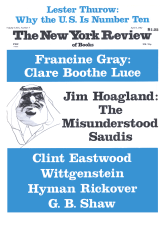In response to:
What Is, and Is Not, Realism? from the February 18, 1982 issue
To the Editors:
For a long time now belief in something called a “modern tradition” in art which began in the nineteenth century has been official academic dogma. Rosen and Zerner in the first pages of their article “What Is, and Is Not Realism” [NYR, February 18], whilst conceding that this tradition has not always been defined with adequate sophistication, reaffirm their belief in it and imply that those of us who object to the division of nineteenth-century art into “avant-grade” and “official” and who question the continuity of the “modern tradition” are enemies of modern art. Of “the historians who detest modern art” they inform us “their name is, if not legion, at least platoon or squadron.” The biblical rhetoric, as well as the whimsical retreat from it, suggests some uncertainty. Can Rosen and Zerner really believe that the “scholars, dealers, and museum curators” engaged in the “mischievous” business of looking afresh at neglected nineteenth-century artists “have no taste for the modern tradition”? In my experience they are generally very well disposed towards modern art and certainly quite as pious about Impressionism (which the “modern tradition” apparently “has at its center”) as Rosen and Zerner.
No doubt confusion has been caused, sometimes deliberately, by recent reevaluations; but how welcome this is after the narrowness of the old textbooks! What a gain it is for instance that there is now no impediment to our recognition of the importance that official commissions for mural paintings of gods and heroes in the grand manner had for Delacroix—he accepted these, by the way, as soon as he got the chance and not “late in life.” Is it really so very blasphemous to be invited to compare the still lives by Manet with those by the “very official” (what can this phrase mean?) Philippe Rousseau or by Bonvin (who is here rebuked for not shocking anyone—a distinction he shares with Chardin). Manet of course craved for official recognition and official commissions. The problem is that he is supposed to occupy a key position in the apostolic succession which connects de Kooning with Delacroix, and which of course also includes Courbet. Rosen and Zerner write very well about Courbet’s realism but they display a desperate agility in their attempt to demonstrate that Manet was really the same sort of painter.
Rosen and Zerner concede that “There is, of course, a great deal of art in the nineteenth century that lies outside the modern tradition, and some of it has attractions for almost anyone today; but most of this art lies on the margins of history. It contributes only in the most insignificant way to major changes in style.” Are we to suppose that art which does not contribute in a significant way to major changes in style (or rather today’s estimates of such) is unworthy of admiration and investigation? What about Vermeer? What about Botticelli (who did make such a contribution, but only a few hundred years after everyone who had heard of him was quite sure that he would never do so)? Bonvin, Delaroche, Meissonier, and Bastien-Lepage may be dull or bad artists, but surely not because their art “lies on the margins of history” (whatever that quaint phrase may mean).
Nicholas Penny
University of Manchester, England
Charles Rosen and Henri Zerner replies:
Any official academic dogma must be debunked: this has been a sound principle of the avant-garde for the past century and a half, and we are pleased that Penny’s thinking is still guided by it. In one respect his letter was very cheering. We tried to put the old dogma of the modern movement briefly in a new light, define its limits, and demonstrate its viability and coherence in a new way, but we were depressed to realize how much of what we had to explain had been rehearsed many times before. But if our article provoked as distinguished a nineteenth-century scholar as Nicholas Penny, it was evidently worth doing.
We hope that most of his objections will have been answered in our second article, which appeared [NYR, March 4] after his letter was written. Some of his points, however, call for comment. The appreciation of Delacroix’s mural decorations in the grand manner is not a recent phenomenon, and today’s historians can take no credit for it: there was never any “impediment to our recognition” of their importance, and we were taught to admire them as small children.
It was generous of Penny to say that he thought we wrote well about Courbet’s realism, but we are puzzled that he found a “desperate agility” in our remarks about Manet—genuinely puzzled, because there are only half a dozen sentences on Manet in our article, almost all of them tediously conventional.
What must have upset Penny is that we treated Manet as an avant-garde artist closely associated with realism and naturalism—but that, of course, is how all of his contemporaries saw him. His craving for official recognition was well known, and his friends and colleagues found it comic and sometimes more than a little absurd. This did not prevent him from being a card-carrying member of the avant-garde. Anton von Webern hoped that one day the postman would whistle a twelve-tone row while delivering the mail, but that does not mean that he is the same kind of composer as Cole Porter.
Penny’s examples of Vermeer, Botticelli, and Chardin are beside the point. We have not suggested that the opposition between academic and avant-garde makes much sense before 1800. The trouble with nineteenth-century art is that it seems to have been almost impossible to be an interesting painter without creating some controversy. Even Corrot had to be defended—and was, above all, by the avant-garde critics.
This Issue
April 1, 1982



